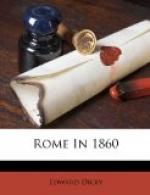the carnival is so notorious, that persons long resident
in Rome possessed the strongest conviction beforehand,
that no human power could ever keep the natives from
the Corso upon Thursday. The day, unlike its
predecessors, was brilliantly bright. The Corso
was decked out as gaily as hangings and awnings could
make it. The sellers of bouquets and “confetti”
were at their posts. A number of carriages were
sent down filled with adherents of the Government,
dressed in carnival attire, to act as decoy-ducks.
All officials were required to take part in the festivities.
The influence of the priests was exerted to beat
up carnival recruits amongst their flocks, and yet
the people obstinately declined coming. The revel
was ready, but the revellers were wanting. The
stiff-necked Romans were not content with stopping
away, but insisted on going elsewhere. By one
of those tacit understandings, which are always the
characteristic of a country without public life or
liberty, a place of rendezvous was fixed upon.
Without notice or proclamation of any kind, everybody
knew somehow, though how, nobody could tell, that
the road beyond the Porta Pia was the place where
people were to meet on the day in question. The
spot was appropriate on various grounds. Along
the Via Nomentana, which leaves Rome through this
gate, lies the Mons Sacer, whither the Plebs of old
seceded from the city, to escape from the tyranny of
their rulers. The gate too, which was commenced
by Michael Angelo, was completed by the present Pontiff,
and there is an irony dear to an Italian’s mind
in the idea of choosing the Porta Pia for the egress
of a demonstration against the Pope Pius. Perhaps,
after all, the fact that the road is one of the sunniest
and pleasantest near Rome may have had more to do with
its selection than any abstract considerations.
Be the cause what it may, one fact is certain, that
from the time when the Corso ought to have been filling,
a multitude of carriages and holiday-dressed people
set out towards the Porta Pia. The Giovedi Grasso
is a feast-day in Rome, and all the shops are shut,
and their owners at liberty. All Rome, in consequence,
seemed to be wending towards the Porta Pia. From
the gate to the convent of St Agnese, a distance of
about a mile, there was a long string of carriages,
chiefly hired vehicles, but filled with well-dressed
persons. As far as I could judge, the number
of private and aristocratic conveyances was small.
The prince of Piombino, who is married to one of
the half-English Borghese princesses, was the only
Roman nobleman I heard of, as being amongst the crowd.
But if the nobility were not present on the Via Nomentana,
they were equally absent from the Corso. The
footpaths were thronged with a dense file of orderly
respectable people. There were, perhaps, half-a-dozen
carriages, the owners of which had some sort of carnival-dress
on, but that was all. There were no cries, no
throwing of confetti, no demonstration of feeling,




